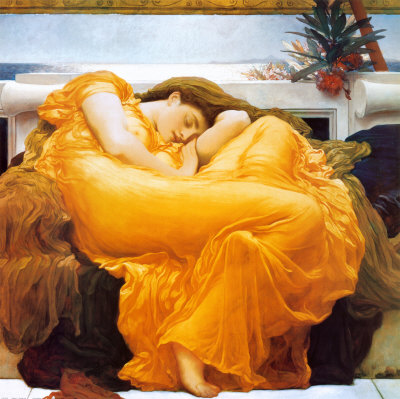Today is the first Sunday of June, so this week’s picture is Flaming June, by Frederic, Lord Leighton. Better known in reproduction than in the flesh, it is one of those paintings to have launched a thousand postcards (not to mention posters and placemats). The work was first exhibited at the Royal Academy in 1896, when the reviewer for The Times gave it his cautious approval: “It is the single figure of a girl asleep in the full June sunlight, in an attitude which the painter has seemingly chosen mainly as an exercise in the drawing of complicated line. The mass of drapery is of that peculiar reddish orange of which Sir Frederic Leighton’s palette seems to possess the secret, and this is harmonised, in that manner of his which is so familiar, against other draperies of dark crimson and pale olive.”
Flaming June was painted near the end of Leighton’s illustrious career as one of the leading classical painters of the Victorian period, and President of the Royal Academy. It is the last and in some ways the most abstract of his many attempts to evoke a story, or conjure a mood, through the depiction of a solitary female figure. A diaphanously clad maiden of uncertain classical origin sits slumped in a marble seat liberally strewn with what appears to be chocolate-brown crepe. Her position may suggest, to modern eyes, the posture of an exhausted aeroplane passenger. In fact her pose is loosely modelled on that of Michelangelo’s famous statue of Night, in the Medici Tombs in Florence, which Leighton regarded as one of the supreme achievements of Western art. The funereal solemnity of Michelangelo’s monumental nude has been considerably warmed up, by the Victorian painter, in the act of appropriating and adapting it. Leighton...


